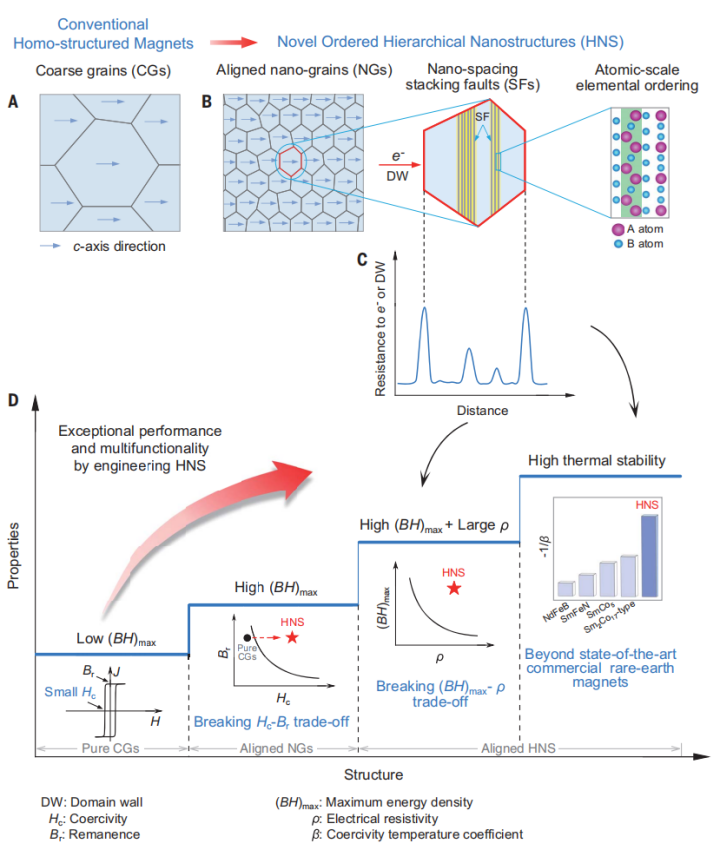Professor Zhang Xiangyi's team at the Extreme Deformation Research Center at the State Key Laboratory of Metastable Materials Science and Technology at YSU has developed a novel strategy involving a hierarchical nanostructure (HNS) in collaboration with other research teams in China. This strategy has successfully resolved the inherent trade-offs in permanent magnet materials, and through experimentation, the team discovered multifunctional ferromagnetic materials. The HNS ferromagnetic materials synthesized through this approach have demonstrated exceptional properties that surpass those of the current high-temperature permanent magnet materials. The electrical resistivity of these materials has increased by 50% to 138%, resulting in the highest energy density achieved to date. Additionally, these materials exhibit enhanced coercivity and thermal stability, outperforming existing rare-earth permanent magnet materials. The research findings are presented in "Fast Fabrication of a Hierarchical Nanostructured Multifunctional Ferromagnet", Science Vol. 385, No. 6709, August 8, 2024, https://www.science.org/doi/10.1126/science.adp2328.
The advent of novel materials with multifunctional attributes is positioned to have a significant impact on social advancement. The urgency for such materials is particularly evident in applications like motors and drivers, which account for over 40% of global electricity consumption. The use of ferromagnetic materials is of paramount importance for these applications. However, a fundamental conflict exists between the desired properties of high saturation magnetization and high coercivity, as well as between high energy density, high electrical resistivity and high thermal stability. It is often the case that improvements in one property come at the expense of other critical properties. The inverse relationships between these fundamental physical properties present a significant challenge for the development of multifunctionality in ferromagnetic materials. These intrinsic trade-offs between multiple properties also impede the discovery of new generations of multifunctional materials.
The research team put forth a design strategy, known as HNS, as illustrated in Figure 1. By employing the straightforward PrCo5 binary alloy as a model material, the researchers were able to manipulate the inherently contradictory energy density, electrical resistivity, and magnetic thermal stability by engineering a rich, ordered HNS, thereby resolving the conflicts between multiple properties in ferromagnetic materials. The HNS permanent magnets prepared using this strategy exhibit high energy density, large electrical resistivity, and high coercivity and thermal stability, outperforming existing high-temperature ferromagnets. In addition to regulating the material's electronic transport and domain wall movement, the HNS strategy can also be employed to control phonon transport and photon transport, as well as the transport of reactants, paving the way for the development of next-generation multifunctional materials.
In stark contrast to conventional complex alloy design methodologies, the HNS strategy can be readily implemented in straightforward binary alloys without the need to introduce additional alloying elements. Consequently, this approach conserves resources and streamlines the material manufacturing process, particularly by circumventing the deterioration of essential properties that can result from the introduction of alloying elements. To obtain the ideal HNS, the research team developed a distinctive high-pressure constrained thermal deformation technology based on Joule heating. This technology enables the rapid synthesis of fully dense bulk materials in a matter of seconds, with controllable fabrication of structures at both the nanoscale and atomic scale, as well as effective control over the structural properties of the material.

Figure 1: Design Strategy for Hierarchical Nanostructures (HNS) and Schematic Diagram of Multifunctional Ferromagnetic Materials
The research results indicate that the HNS strategy can effectively address the significant challenges faced in the synthesis of multifunctional materials. The established high-pressure constrained thermal deformation technology provides a rapid manufacturing platform for bulk materials with nanoscale structural characteristics, which is of great significance for the development and application of next-generation multifunctional materials. This technology can also be leveraged to discover various metastable structures and metastable phase materials that traditional preparation techniques cannot obtain.
The research was supported by projects such as the National Natural Science Foundation of China (51931007, U22A20116, 52071279, 52271236) and the National Key Research and Development Program of China (2022YFB3505600). The related technologies and inventions have been granted invention patents in China, the United States, and Japan. Dr. Hua Yingxin and Professor Li Xiaohong from the University are the co-first authors of the paper.